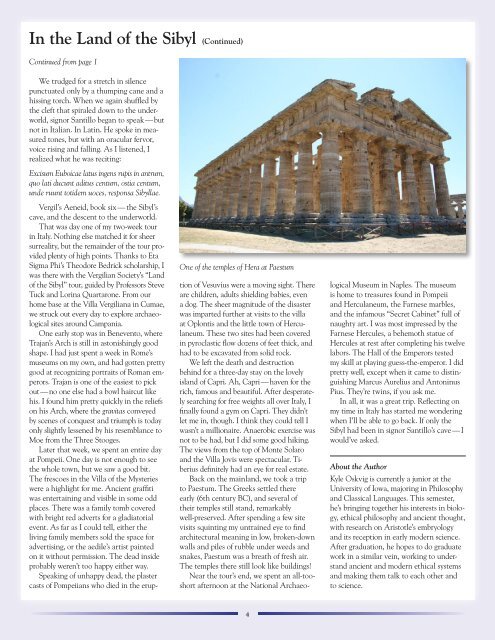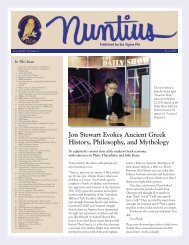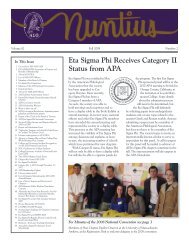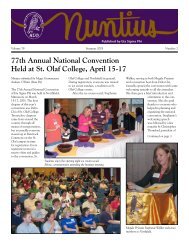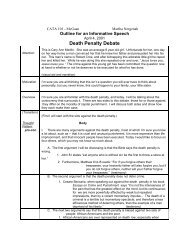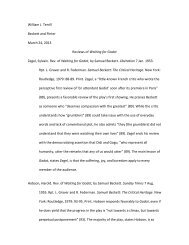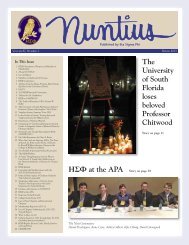In the Land of the Sibyl - Monmouth College
In the Land of the Sibyl - Monmouth College
In the Land of the Sibyl - Monmouth College
You also want an ePaper? Increase the reach of your titles
YUMPU automatically turns print PDFs into web optimized ePapers that Google loves.
<strong>In</strong> <strong>the</strong> <strong>Land</strong> <strong>of</strong> <strong>the</strong> <strong>Sibyl</strong> (Continued)<br />
Continued from page 1<br />
We trudged for a stretch in silence<br />
punctuated only by a thumping cane and a<br />
hissing torch. When we again shuffled by<br />
<strong>the</strong> cleft that spiraled down to <strong>the</strong> underworld,<br />
signor Santillo began to speak — but<br />
not in Italian. <strong>In</strong> Latin. He spoke in measured<br />
tones, but with an oracular fervor,<br />
voice rising and falling. As I listened, I<br />
realized what he was reciting:<br />
Excisum Euboicae latus ingens rupis in antrum,<br />
quo lati ducunt aditus centum, ostia centum,<br />
unde ruunt totidem uoces, responsa <strong>Sibyl</strong>lae.<br />
One <strong>of</strong> <strong>the</strong> temples <strong>of</strong> Hera at Paestum<br />
tion <strong>of</strong> Vesuvius were a moving sight. There<br />
are children, adults shielding babies, even<br />
a dog. The sheer magnitude <strong>of</strong> <strong>the</strong> disaster<br />
was imparted fur<strong>the</strong>r at visits to <strong>the</strong> villa<br />
at Oplontis and <strong>the</strong> little town <strong>of</strong> Herculaneum.<br />
These two sites had been covered<br />
in pyroclastic flow dozens <strong>of</strong> feet thick, and<br />
had to be excavated from solid rock.<br />
We left <strong>the</strong> death and destruction<br />
behind for a three-day stay on <strong>the</strong> lovely<br />
island <strong>of</strong> Capri. Ah, Capri — haven for <strong>the</strong><br />
rich, famous and beautiful. After desperately<br />
searching for free weights all over Italy, I<br />
finally found a gym on Capri. They didn’t<br />
let me in, though. I think <strong>the</strong>y could tell I<br />
wasn’t a millionaire. Anaerobic exercise was<br />
not to be had, but I did some good hiking.<br />
The views from <strong>the</strong> top <strong>of</strong> Monte Solaro<br />
and <strong>the</strong> Villa Jovis were spectacular. Tiberius<br />
definitely had an eye for real estate.<br />
Back on <strong>the</strong> mainland, we took a trip<br />
to Paestum. The Greeks settled <strong>the</strong>re<br />
early (6th century BC), and several <strong>of</strong><br />
<strong>the</strong>ir temples still stand, remarkably<br />
well-preserved. After spending a few site<br />
visits squinting my untrained eye to find<br />
architectural meaning in low, broken-down<br />
walls and piles <strong>of</strong> rubble under weeds and<br />
snakes, Paestum was a breath <strong>of</strong> fresh air.<br />
The temples <strong>the</strong>re still look like buildings!<br />
Near <strong>the</strong> tour’s end, we spent an all-tooshort<br />
afternoon at <strong>the</strong> National Archaeo-<br />
Vergil’s Aeneid, book six — <strong>the</strong> <strong>Sibyl</strong>’s<br />
cave, and <strong>the</strong> descent to <strong>the</strong> underworld.<br />
That was day one <strong>of</strong> my two-week tour<br />
in Italy. Nothing else matched it for sheer<br />
surreality, but <strong>the</strong> remainder <strong>of</strong> <strong>the</strong> tour provided<br />
plenty <strong>of</strong> high points. Thanks to Eta<br />
Sigma Phi’s Theodore Bedrick scholarship, I<br />
was <strong>the</strong>re with <strong>the</strong> Vergilian Society’s “<strong>Land</strong><br />
<strong>of</strong> <strong>the</strong> <strong>Sibyl</strong>” tour, guided by Pr<strong>of</strong>essors Steve<br />
Tuck and Lorina Quartarone. From our<br />
home base at <strong>the</strong> Villa Vergiliana in Cumae,<br />
we struck out every day to explore archaeological<br />
sites around Campania.<br />
One early stop was in Benevento, where<br />
Trajan’s Arch is still in astonishingly good<br />
shape. I had just spent a week in Rome’s<br />
museums on my own, and had gotten pretty<br />
good at recognizing portraits <strong>of</strong> Roman emperors.<br />
Trajan is one <strong>of</strong> <strong>the</strong> easiest to pick<br />
out — no one else had a bowl haircut like<br />
his. I found him pretty quickly in <strong>the</strong> reliefs<br />
on his Arch, where <strong>the</strong> gravitas conveyed<br />
by scenes <strong>of</strong> conquest and triumph is today<br />
only slightly lessened by his resemblance to<br />
Moe from <strong>the</strong> Three Stooges.<br />
Later that week, we spent an entire day<br />
at Pompeii. One day is not enough to see<br />
<strong>the</strong> whole town, but we saw a good bit.<br />
The frescoes in <strong>the</strong> Villa <strong>of</strong> <strong>the</strong> Mysteries<br />
were a highlight for me. Ancient graffiti<br />
was entertaining and visible in some odd<br />
places. There was a family tomb covered<br />
with bright red adverts for a gladiatorial<br />
event. As far as I could tell, ei<strong>the</strong>r <strong>the</strong><br />
living family members sold <strong>the</strong> space for<br />
advertising, or <strong>the</strong> aedile’s artist painted<br />
on it without permission. The dead inside<br />
probably weren’t too happy ei<strong>the</strong>r way.<br />
Speaking <strong>of</strong> unhappy dead, <strong>the</strong> plaster<br />
casts <strong>of</strong> Pompeiians who died in <strong>the</strong> eruplogical<br />
Museum in Naples. The museum<br />
is home to treasures found in Pompeii<br />
and Herculaneum, <strong>the</strong> Farnese marbles,<br />
and <strong>the</strong> infamous “Secret Cabinet” full <strong>of</strong><br />
naughty art. I was most impressed by <strong>the</strong><br />
Farnese Hercules, a behemoth statue <strong>of</strong><br />
Hercules at rest after completing his twelve<br />
labors. The Hall <strong>of</strong> <strong>the</strong> Emperors tested<br />
my skill at playing guess-<strong>the</strong>-emperor. I did<br />
pretty well, except when it came to distinguishing<br />
Marcus Aurelius and Antoninus<br />
Pius. They’re twins, if you ask me.<br />
<strong>In</strong> all, it was a great trip. Reflecting on<br />
my time in Italy has started me wondering<br />
when I’ll be able to go back. If only <strong>the</strong><br />
<strong>Sibyl</strong> had been in signor Santillo’s cave — I<br />
would’ve asked.<br />
About <strong>the</strong> Author<br />
Kyle Oskvig is currently a junior at <strong>the</strong><br />
University <strong>of</strong> Iowa, majoring in Philosophy<br />
and Classical Languages. This semester,<br />
he’s bringing toge<strong>the</strong>r his interests in biology,<br />
ethical philosophy and ancient thought,<br />
with research on Aristotle’s embryology<br />
and its reception in early modern science.<br />
After graduation, he hopes to do graduate<br />
work in a similar vein, working to understand<br />
ancient and modern ethical systems<br />
and making <strong>the</strong>m talk to each o<strong>the</strong>r and<br />
to science.<br />
4


